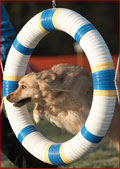Teaching Your Dog How To Track
Teaching your dog to track takes more time and physical space than any of the basic obedience exercises. Also, some breeds of dogs are better at tracking and have better "noses" than others. Among the better tracking breeds are bloodhounds, beagles, most of the hound breeds, German shepherds and collies. For these exercises you will need some equipment. A harness is necessary for this kind of training, since your dog will be pulling you at times. A slip chain collar won't do, since it will be tightening on his neck. The leash must be at least 30 feet long and be made of a flat fabric or leather if possible.
You will also need several leather articles that you will drop when laying the track. Old gloves or wallets would be ideal. You will also need four trail markers. Stakes about five feet long with streamers attached at the top will do just fine. The shoes you should wear need to be leather-soled and not rubber or composition soled. The reason is that the rubber or composition soles will give off an odor that could confuse the dog in the beginning lessons and wouldn't be suitable for the track.
The time of day and the weather are also important considerations in teaching your dog to track. Generally the scent will be stronger in the early morning or after sundown. Also, a damp or humid day is preferred over a dry, low humid, sunny day. And a calm non-windy day is better than a windy one. When picking the area to lay the track, avoid one in which there are unusually strong odors such as road tar, gasoline, cattle pens, etc. Choose an open area such as a meadow or field where the grass is tall and preferably damp.
Start the exercise by first putting the harness on your dog and placing him out of sight while you lay the track. Make sure you have several tasty treats in your pocket. Next, take one of your stakes and pick a starting point. Scrape the dirt with your heel, overturn it and drive the stake into the disturbed soil. Start walking from the stake downwind in a straight line for about 100 feet and drop the leather article. Walk a few feet further in a straight line, drop another, then walk a little further and drop the third one. Then turn around and backtrack your trail taking care that you walk the same line you originally walked.
Now while the trail is fresh take your dog from his "hiding place" and put on the 30-foot lead. Bring him to the stake and put him into the "down" position where his nose can smell your overturned soil and the stake. Give him about ten feet of the lead, keeping the rest coiled up in your hand. Then gently push your dog's nose into the overturned soil so he can get the scent and hold it there for several seconds. Now, give him an excited command such as "look for it"! and point to the ground helping him to find the scent. Repeat the command along with lots of praise such as "good boy"!
Encourage your dog to walk in front of you and not to "heel". If he picks up the scent keep on giving him the excited command and praise. When he finds the first article, get him to pick it up and praise him like he's just done the best thing in the world! Give him one treat, lead him back to the stake and repeat the process for the 2nd and 3rd article. This will be enough for the first lesson.
When your dog becomes proficient on the straight track, you can start introducing turns by driving your stakes into each turn, walk another 100 feet down that turn, drop the article and repeat the process for the other turns. Then backtrack to the first stake. Teach your dog the turns the same way you taught him the straight track. Keep on practicing these tracking exercises with your dog! When he becomes an expert, you can discontinue the stakes. Soon your dog will be tracking all by himself!
From:ezinearticles.com







 Ontario Dog Sports
Ontario Dog Sports
Reader Comments